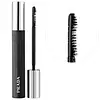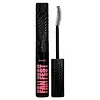Prada Pradascope Lash Lifting & Lengthening Mascara Versus Benefit Cosmetics Fan Fest Fanning Volumising Mascara
What's inside
What's inside
 Key Ingredients
Key Ingredients

 Benefits
Benefits

 Concerns
Concerns

No concerns
 Ingredients Side-by-side
Ingredients Side-by-side

Water
Skin ConditioningOryza Sativa Cera
Skin ConditioningCI 77499
Cosmetic ColorantPotassium Cetyl Phosphate
EmulsifyingAcrylates Copolymer
Cera Alba
EmollientCopernicia Cerifera Cera
EmollientSteareth-2
EmulsifyingPentylene Glycol
Skin ConditioningCetyl Alcohol
EmollientHydroxyethylcellulose
Emulsion StabilisingAcacia Senegal Gum
MaskingSodium Dehydroacetate
PreservativeCaprylyl Glycol
EmollientHydrogenated Jojoba Oil
AbrasiveHydrogenated Palm Oil
EmollientHydrolyzed Hyaluronic Acid
HumectantLaureth-21
CleansingLactic Acid
BufferingSodium Hyaluronate
HumectantWater, Oryza Sativa Cera, CI 77499, Potassium Cetyl Phosphate, Acrylates Copolymer, Cera Alba, Copernicia Cerifera Cera, Steareth-2, Pentylene Glycol, Cetyl Alcohol, Hydroxyethylcellulose, Acacia Senegal Gum, Sodium Dehydroacetate, Caprylyl Glycol, Hydrogenated Jojoba Oil, Hydrogenated Palm Oil, Hydrolyzed Hyaluronic Acid, Laureth-21, Lactic Acid, Sodium Hyaluronate
Water
Skin ConditioningCera Alba
EmollientPolyacrylate-21
Hydrogenated Olive Oil Stearyl Esters
Emulsion StabilisingVp/Eicosene Copolymer
Polybutene
Oryza Sativa Bran Wax
Skin ConditioningStearyl Alcohol
EmollientCopernicia Cerifera Wax
Palmitic Acid
EmollientStearic Acid
CleansingAcacia Senegal Gum
MaskingButylene Glycol
HumectantAminomethyl Propanediol
Buffering1,2-Hexanediol
Skin ConditioningPanthenol
Skin ConditioningCaprylyl Glycol
EmollientChlorphenesin
AntimicrobialHydroxyacetophenone
AntioxidantTrideceth-6 Phosphate
EmulsifyingVaccinium Macrocarpon Seed Oil
Skin ConditioningSodium Dilauramidoglutamide Lysine
HumectantTocopheryl Acetate
AntioxidantDipropylene Glycol
HumectantGlyceryl Caprylate
EmollientHelianthus Annuus Seed Oil
EmollientRosmarinus Officinalis Leaf Extract
AntimicrobialCI 77499
Cosmetic ColorantWater, Cera Alba, Polyacrylate-21, Hydrogenated Olive Oil Stearyl Esters, Vp/Eicosene Copolymer, Polybutene, Oryza Sativa Bran Wax, Stearyl Alcohol, Copernicia Cerifera Wax, Palmitic Acid, Stearic Acid, Acacia Senegal Gum, Butylene Glycol, Aminomethyl Propanediol, 1,2-Hexanediol, Panthenol, Caprylyl Glycol, Chlorphenesin, Hydroxyacetophenone, Trideceth-6 Phosphate, Vaccinium Macrocarpon Seed Oil, Sodium Dilauramidoglutamide Lysine, Tocopheryl Acetate, Dipropylene Glycol, Glyceryl Caprylate, Helianthus Annuus Seed Oil, Rosmarinus Officinalis Leaf Extract, CI 77499
 Reviews
Reviews

Ingredients Explained
These ingredients are found in both products.
Ingredients higher up in an ingredient list are typically present in a larger amount.
Acacia Senegal Gum has skin soothing, thickening, and formulation stabilizing properties. It comes from the Acacia tree that is native to sub-Saharan Africa.
Caprylyl Glycol is a humectant and emollient, meaning it attracts and preserves moisture.
It is a common ingredient in many products, especially those designed to hydrate skin. The primary benefits are retaining moisture, skin softening, and promoting a healthy skin barrier.
Though Caprylyl Glycol is an alcohol derived from fatty acids, it is not the kind that can dry out skin.
This ingredient is also used as a preservative to extend the life of products. It has slight antimicrobial properties.
Learn more about Caprylyl GlycolCera alba is beeswax, or the wax used by bees to make honeycombs. It is a texture-enhancer and emollient. A study from 2003 found beeswax to be a stronger emollient than ingredients such as petroleum jelly.
As an emollient, beeswax helps hydrate the skin by creating a barrier on top. This barrier traps moisture in.
Emulsifiers help prevent ingredients from separating. This helps create consistent texture.
The structure of beeswax is mainly long-chain alcohols and the esters of fatty acids.
There are three types of beeswax: yellow, white, and absolute. Yellow is pure beeswax taken from the honeycomb. White beeswax is created by filtering or bleaching yellow beeswax. Absolute beeswax is created by treating beeswax with alcohol. Beeswax used in cosmetics are purified.
Beeswax has been used throughout history and even in prehistoric times. Some common uses for beeswax still used today are making candles, as a waterproofing agent, and polish for leather.
Learn more about Cera AlbaCi 77499 is also hydrated iron III oxide. It is created from mixing red and black iron oxides. This helps give shades of darkness to a product.
Iron III oxides are classified as inorganic chemicals for coloring.
Water. It's the most common cosmetic ingredient of all. You'll usually see it at the top of ingredient lists, meaning that it makes up the largest part of the product.
So why is it so popular? Water most often acts as a solvent - this means that it helps dissolve other ingredients into the formulation.
You'll also recognize water as that liquid we all need to stay alive. If you see this, drink a glass of water. Stay hydrated!
Learn more about Water